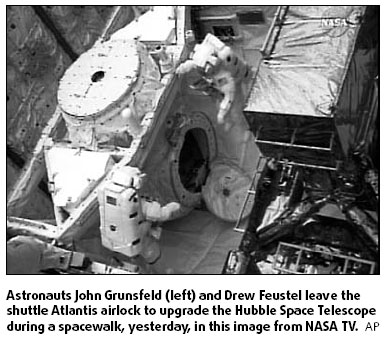Astronauts leave shuttle to work on Hubble
HOUSTON: A pair of spacewalking astronauts floated outside the space shuttle Atlantis yesterday to work on the Hubble Space Telescope, a 19-year-old observatory that has changed scientists' understanding of the universe.
Clad in bulky pressurized spacesuits, five-time shuttle flier John Grunsfeld, 50, and rookie partner Andrew Feustel, 43, left Atlantis' airlock just before 9 am EDT (9 pm Beijing time) for the first of five spacewalks. The astronauts are to repair the telescope and install new instruments that will allow Hubble to capture images of objects formed as early as about 500 years after the birth of the universe.
"Oh this is fantastic," said Grunsfeld, a member of two previous Hubble servicing crews. "You're going to love this Drew," he told Feustel.
Atlantis and seven astronauts blasted off on Monday for an 11-day mission.
The astronauts' first job is to replace the telescope's 1990s-era digital camera with an upgraded imager that is sensitive to infrared and ultraviolet light in addition to the visible wavelengths that the human eye can detect.
The infrared detectors are particularly important for imaging very distant objects, whose light comes to Earth shifted into longer, redder wavelengths similar to how the sound of a train shifts as it recedes into the distance.
"This new camera promises to see further back in time, closer to the Big Bang, than we've ever been able to see before," Grunsfeld said in a preflight interview.
Taking a long, deep look for the most distant objects detectable tops Hubble's to-do list once the observatory is back in service. The oldest targets Hubble has seen date back to 700 million years after the Big Bang, the explosion that created the universe about 13.7 billion years ago.

Grunsfeld, an astronomer by training, has a research project pending with the new camera. He wants to use its ultraviolet sensors to study a crater on the moon in hopes of finding minerals that could be useful for future lunar expeditions.
Grunsfeld and Feustel also are scheduled to replace a key computer that processes and formats information collected by Hubble's science instruments for transmission to the ground.
The computer shut down last September, just a few weeks before the Hubble servicing mission had been scheduled to fly.
NASA delayed the mission so engineers could prepare a spare. Telescope operators switched to a backup system in the meantime.
NASA wants to leave Hubble with as much spare equipment as possible in hopes of keeping it operational until at least 2014, by which time its replacement should be operational.
'Rescue mission'
The space shuttle Endeavour is perched on a launch pad at the Kennedy Space Center and ready to lift off within days. But this mission is one NASA hopes will never fly.
The shuttle is poised, if needed, to rescue the seven astronauts on the shuttle Atlantis if they can't make it home on their own ship.
NASA sees little chance the mission will ever take place. Safety upgrades have greatly reduced the chance of damage from debris hitting the shuttle during launch - the scenario that doomed the shuttle Columbia in 2003.
The Columbia disaster prompted NASA to develop new repair techniques and tools. In a worst case scenario, crews also could await a rescue on the International Space Station.
But the Atlantis mission is a special case. Sent to repair the Hubble Space Telescope, which orbits at a different level, the shuttle cannot reach the station, even in an emergency. So NASA devised a backup plan: Prepare a second shuttle and crew for launch.
Under the plan, Endeavour could lift off as early as Monday with a four-person crew and extra seating for Atlantis' seven astronauts, if Atlantis were found to be severely damaged.
Reuters
(China Daily 05/15/2009 page11)








